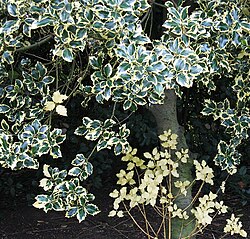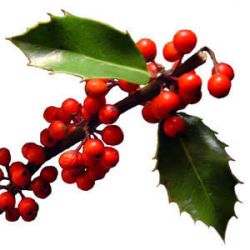Ilex
Holly (Ilex) is a genus of about 400 species of flowering plants in the family Aquifoliaceae, and the only genus in that family. They are shrubs and trees from 2–25 m tall, with a wide distribution in Asia, Europe, north Africa, and North and South America. Many species are quite attractive, and are a fixture in both formal and informal gardens. The evergreen species in particular are used for winter interest, but some of the deciduous species are equally useful for their heavy sets of bright berries.

Holly berries are mildly toxic and will cause vomiting and/or diarrhea when ingested by people. However they are extremely important food for numerous species of birds, and also are eaten by other wild animals. In the fall and early winter the berries are hard and apparently unpalatable. After being frozen or frosted several times, the berries soften, and become edible. During winter storms, birds often take refuge in hollies, which provide shelter, protection from predators (by the spiny leaves), and food.
In many Western cultures, holly is a traditional Christmas decoration, used especially in wreaths. The wood is heavy, hard and white; one traditional use is for chess pieces, with holly for the white pieces, and ebony for the black. Other uses include turnery, inlay work and as firewood. Looms in the 1800s used holly for the spinning rod. Because holly is dense and can be sanded very smooth, the rod was less likely than other woods to snag threads being used to make cloth.
Several American holly species are also used to make various caffeine rich teas. The South American I. paraguariensis is used to make yerba mate, a common drink. Ilex guayusa is used both as a stimulant and as an admixture to the entheogenic tea ayahuasca; The leaves of I. guayusa have the highest caffeine content of any known plant. In Northern and Central America, Ilex vomitoria, Yaupon holly, was used by southeastern American Indians as a ceremonial stimulant and emetic known as the black drink. In China, the young leaf buds of Ilex kudingcha are process in a method similar to green tea to make a tisane called Ku Ding tea
Description
[edit | edit source]The leaves are simple, and can be either deciduous or evergreen depending on the species, and may be entire, finely toothed, or with widely-spaced, spine-tipped leaves. Hollies are mostly dioecious, with male and female flowers on different plants, with some exceptions. Pollination is mainly by bees and other insects. The fruit is a small berry, usually red when mature, with one to ten seeds.
Species
[edit | edit source]- Ilex aquifolium - w:European Holly
- Ilex cornuta - w:Chinese Holly
- Ilex crenata - w:Japanese Holly
- Ilex decidua - w:Possumhaw
- Ilex dipyrena - Himalayan Holly
- Ilex glabra - Gallberry, Inkberry
- Ilex integra
- Ilex opaca - American Holly
- Ilex paraguariensis - Yerba Mate
- Ilex pedunculosa
- Ilex serrata - Japanese Winterberry
- Ilex verticillata - American Winterberry
- Ilex vomitoria - Yaupon Holly
Pests and Diseases
[edit | edit source]
Arthropod Pests
[edit | edit source]- Black Citrus Aphid: Toxoptera aurantii
- California red scale: Aonidiella aurantii
- Oleander scale: Aspidiotus nerii
- India Wax Scale: Ceroplastes ceriferus
- Florida Wax Scale: Ceroplastes floridensis
- Tea scale: Fiorinia theae
- Greedy scale: Hemiberlesia rapax
- Camellia Scale: Lepidosaphes camelliae
- Oystershell scale: Lepidosaphes ulmi
- Gloomy Scale: Melanaspis tenebricosa (on I. glabra)
- White Peach Scale: Pseudaulcapsis pentagona
- Black scale: Saissetia oleae
- Euonymus Scale: Unaspis euonymi
- Cottony Camellia Scale: Pulvinaria floccifera
- Cottony Maple Leaf Scale: Pulvinaria acericola
- Holly Pit Scale: Asterolecanium puteanum
- Holly scale
- Lecanium scale: Lecanium spp.
- Nigra Scale: Parasaissetia nigra
- Walnut Scale: Quadraspidiotus juglansregiae
- Yaupon Psyllid
- Citrus Whitefly: Dialeurodes citri
- Greenhouse Whitefly: Trialeurodes vaporariorum
- Mulberry Whitefly: Tetraleurodes mori
- Two-lined Spittlebug
- Striped Mealybug: Ferrisia sp.
- Comstock Mealybug: Pseudococcus comstocki
- Berry Midge: Asphondylia ilicicola: infests the berries, preventing coloring.
- Holly Leaf Miner: Phytomyza ilicis: maggot yellowish white, adult a black fly, flying in early spring
- American Holly Leaf Miner: Phytomyza ilicicola: mines slender.
- Twig Pruner: Elaphidionoides villosus
- Twig Girdler: Oncideres cingulata
- Japanese Beetle: Popillia japonica
- Black Blister Beetle
- Potato Flea Beetle
- Black Vine Weevil: Otiorhynchus sulcatus
- Japanese Weevil: Pseudocneorhinus bifasciatus
- Holly Looper: Thysanopyga intractata
- Bud Moth: Rhopobota naevana ilicifolia in Pacific Northwest
- Fall Webworm
- Holly Bud Moth (Blackheaded Fireworm)
- Southern Red Mite: Oligonichus ilicis
Pathogens
[edit | edit source]- Bacterial blight caused by Corynebacterium illicis
- Powdery Mildews caused by Microsphaera alni and Phyllactinia corylea
- Anthracnose caused by Elsinoë ilicis
- Tar Spots and Leaf Spots caused by numerous fungal pathogens
- Cankers caused by Diaporthe eres, Diplodia spp., Gloeosporium spp., Nectria coccinea, Physalospora ilicis, and Phomopsis crustosa
- Root Rot caused by Phytophthora spp.
- Leaf Drop caused by Pellicularia filamentosa, which invades foliage in the Rhizoctonia stage, soilborne, affecting cuttings and branches on the ground, affecting American Hollies.
- Flower Blights caused by Botrytis spp. on American hollies, and Thielaviopsis basicola, causing Black knot disease
- Twig Blight caused by Phytophthora ilicis is a problem in Pacific Northwest region of the United States:
- Root Knot caused by nematodes
Other problems
[edit | edit source]- Spine Spot is caused by spines impaling leaves due to winds, particularly a problem in winter
- Winter Scorching of the foliage may occur due to wind and sun exposure in winter.
- Copper Burn occurs when copper sprays are applied to or drift onto hollies. Copper-based sprays should never be applied on or near hollies for this reason.
- Deer browsing may occur on hollies in the United states, particularly to unspined or sparsely spined species.
References
[edit | edit source]- Germplasm Resources Information Network: Ilex species list
- Flora of China: Ilex species list
- Flora of Ecuador: Ilex
- Flora Europaea: Ilex species list
- Flora of Nepal: Ilex species list
- USDA Plants Profile: Ilex
- Diseases & Pests of Ornamental Plants, P. P. Pirone, pages 311-314
- Garden Insects of North America: The Ultimate Guide to Backyard Bugs, Whitney Cranshaw, page 600 (index page)

